Related Research Articles

Chaozhou, alternatively Chiuchow, Chaochow or Teochew, is a city in the eastern Guangdong province of China. It borders Shantou to the south, Jieyang to the southwest, Meizhou to the northwest, the province of Fujian to the east, and the South China Sea to the southeast. It is administered as a prefecture-level city with a jurisdiction area of 3,110 km2 (1,200 sq mi) and a total population of 2,568,387. Its built-up area encompassing most of Shantou and Jieyang cities was home to 12,543,024 inhabitants on 13 local administrative areas. Along with Shantou and Jieyang, Chaozhou is a cultural center of the Chaoshan region.

Sham Shui Po is an area of Kowloon, Hong Kong, situated in the northwestern part of the Kowloon Peninsula, north of Tai Kok Tsui, east of Cheung Sha Wan and south of Shek Kip Mei (石硤尾). It is located in and is the namesake of the Sham Shui Po District.
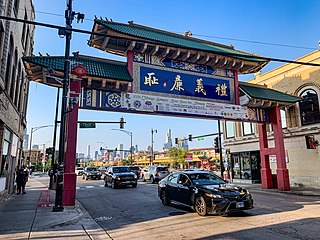
Chinatown is a neighborhood on the South Side of Chicago, along S. Wentworth Avenue between Cermak Road and W. 26th St. Over a third of Chicago's Chinese population resides in this ethnic enclave, making it one of the largest concentrations of Chinese-Americans in the United States. It formed around 1912, after settlers moved south from near the Loop, where the first enclaves were established in the 19th century.
Chinatown is a subzone and ethnic enclave located within the Outram district in the Central Area of Singapore. Featuring distinctly Chinese cultural elements, Chinatown has had a historically concentrated ethnic Chinese population.

Chung Cheng High School (Main) is a co-educational government-aided autonomous Special Assistance Plan (SAP) secondary school in Singapore. Founded in 1939, it is one of the eleven SAP secondary schools in Singapore. Another Secondary School in Singapore, Chung Cheng High School (Yishun), is its sister school.
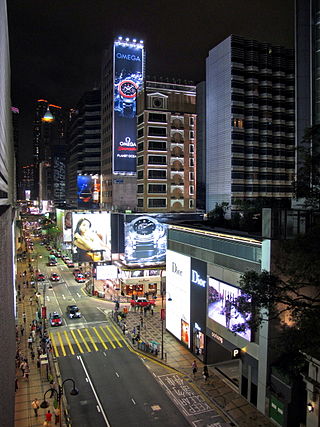
Canton Road is a major road in Hong Kong, linking the former west reclamation shore in Tsim Sha Tsui, Jordan, Yau Ma Tei, Mong Kok and Prince Edward on the Kowloon Peninsula. The road runs mostly parallel and west to Nathan Road. It starts from the junction with Salisbury Road in the south and ends in the north at the junction with Lai Chi Kok Road in the Prince Edward area. The southern section of Canton Road is home to many upscale retail shops, shopping centres and others business establishments, with busy traffic from both vehicles and pedestrians from morning till late at night.

Maris Stella High School (MSHS) (Chinese: 海星中学; pinyin: Hǎixīng Zhōngxué) is a government-aided, all-boys Catholic secondary school with autonomous status. As a full school, it comprises a primary section offering a six-year programme leading up to the Primary School Leaving Examination, as well as a secondary section offering a four-year programme leading up to the Singapore-Cambridge GCE Ordinary Level examinations. Run by the international Marist Brothers at Mount Vernon Road, Singapore near Bartley MRT station, Maris Stella High School is one of the eleven Special Assistance Plan(SAP) high schools in Singapore.
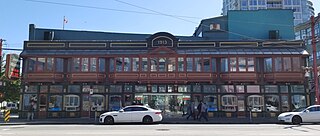
The Sam Kee Building, also known as the Jack Chow Building, is a commercial building in Vancouver, British Columbia, Canada, located near the entrance to the city's Chinatown. It is recognized by Guinness World Records as the "narrowest commercial building in the world".
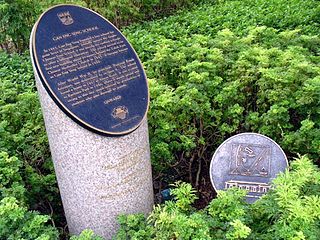
The Gan Eng Seng School's Founding Site, marked by twin commemorative plaques at present, is located at the junction of Telok Ayer Street and Cecil Street in the southern part of Singapore, near the Telok Ayer Chinese Methodist Church. On 30 August 1997, the site was designated as a national historical site along with five other schools by the National Heritage Board (NHB), being one of the oldest educational establishments in Singapore. The others are Raffles Institution, Raffles Girls' School, St Margaret's Secondary School, Singapore Chinese Girls' School and Anglo-Chinese School.

The Ee Hoe Hean Club, founded in 1895 and located at Bukit Pasoh Road in Chinatown, was a millionaires' club in Singapore. Besides functioning as a social and business club, members of the club were actively involved in the political development of China in the early 20th century. The club supported the 1911 Xinhai Revolution which overthrew the Qing Dynasty, and later the establishment of the Republic of China. During World War II, it was the headquarters of the anti-Japanese China Salvation Movement in Southeast Asia from 1937 to 1942. On 18 October 1995, the club was gazetted as a Heritage Site by the National Heritage Board of Singapore.

Yue Hwa Building is a historic building located at the junction of Eu Tong Sen Street and Upper Cross Street in Chinatown, Singapore, next to Chinatown MRT station. Built by Swan and Maclaren in 1927, it was then the tallest building in Chinatown and was known as Nam Tin Building (南天大厦), owned by Lum Chang Holdings. The building housed the six-storey Great Southern Hotel, along with a few shops and cabarets that were popular among Chinese travellers. In 1993, Lum Chang Holdings sold the building to Hong Kong businessman Yu Kwok Chun, who converted it to the first Yue Hwa Chinese Products department store in Singapore in 1994. The renovation process, which conserved the exterior while adding features such as an atrium and waterfall to the interior, won the building the Architectural Heritage Award by the Urban Redevelopment Authority in 1997.
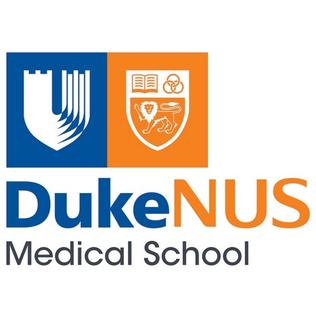
The Duke–NUS Medical School (Duke–NUS) is a graduate medical school in Singapore. The school was set up in April 2005 as the Duke–NUS Graduate Medical School, Singapore's second medical school, after the Yong Loo Lin School of Medicine, and before the Lee Kong Chian School of Medicine. It is a collaboration between Duke University in the United States and the National University of Singapore in Singapore. Duke-NUS follows the American model of post-baccalaureate medical education, in which students begin their medical studies after earning a bachelor's degree. Students are awarded degrees from both Duke University and the National University of Singapore.
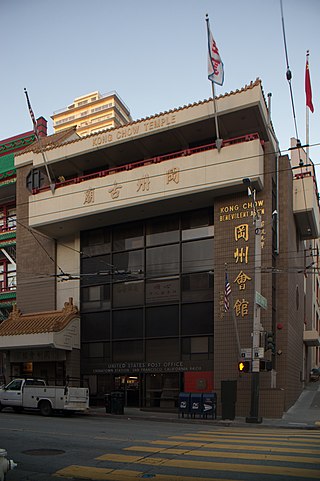
Kong Chow Temple is a temple dedicated to Guan Di, located in the Chinatown neighborhood of San Francisco, California, in the United States.
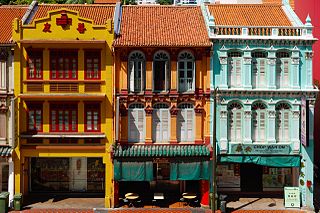
Sino-Portuguese architecture, also known as Chinese Baroque,Straits/Singapore Eclectic architecture or Peranakan architecture is an Asian hybrid style incorporating elements of both Chinese and Portuguese architectural styles. It is common in urban centers where Chinese settlers lived in southern China and the Peranakans of the Malay Peninsula, with examples found and most prominently conserved and maintained in Singapore.

Mon Keang School is a Chinese school located inside the Wongs' Benevolent Association Building at 123A East Pender Street, in the Chinatown of Vancouver, British Columbia, Canada. Classes have historically been taught in Cantonese, the prestige variety of Yue Chinese.

Singapore Calligraphy Centre, also known as 48 Waterloo Street, is a bungalow on Waterloo Street in downtown Singapore which currently houses the Chinese Calligraphy Society Of Singapore.

42 Waterloo Street is a historic bungalow on Waterloo Street in downtown Singapore, which currently houses Centre 42.

60 Waterloo Street is a historic bungalow on Waterloo Street in downtown Singapore. A second four-storey building was constructed behind the bungalow when the Dance Ensemble Singapore moved into the bungalow in 1995.

Dutch Pavilion is a building within the grounds of the Shangri-La Singapore hotel on Orange Grove Road in Tanglin, Singapore. Previously the premises of the Hollandse School, it currently serves as a wedding venue.
The Singapore Handicraft Centre was an arts and crafts centre at the corner of Tanglin Road and Grange Road at the end of the Orchard Planning Area in Singapore. It was completed in 1976 to "preserve and promote the culture of neighbouring regions while ensuring a livelihood for skilled craftsmen". The centre closed down in 1990 and was subsequently demolished to make way for the Tanglin Mall.
References
- 1 2 3 "Kong Chow Wui Koon". Roots. National Heritage Board . Retrieved 2 June 2024.
- 1 2 "KONG CHOW WUI KOON". ura.gov.sg. Urban Redevelopment Authority . Retrieved 2 June 2024.
- 1 2 "Kong Chow School". MOE Heritage Centre . Ministry of Education . Retrieved 2 June 2024.
- ↑ "Clan building a big tourist draw". Singapore Monitor. Singapore. 10 June 1985. Retrieved 2 June 2024.
- ↑ Leong, Weng Kam (21 July 2013). "Clan opens doors to tell story of Chinese immigrants". The Straits Times . Singapore.
- ↑ "Kong Chow Cultural Centre". The Straits Times . Singapore. 8 October 2013.
- ↑ "Kong Chow Wui Koon". Roots. National Heritage Board . Retrieved 2 June 2024.